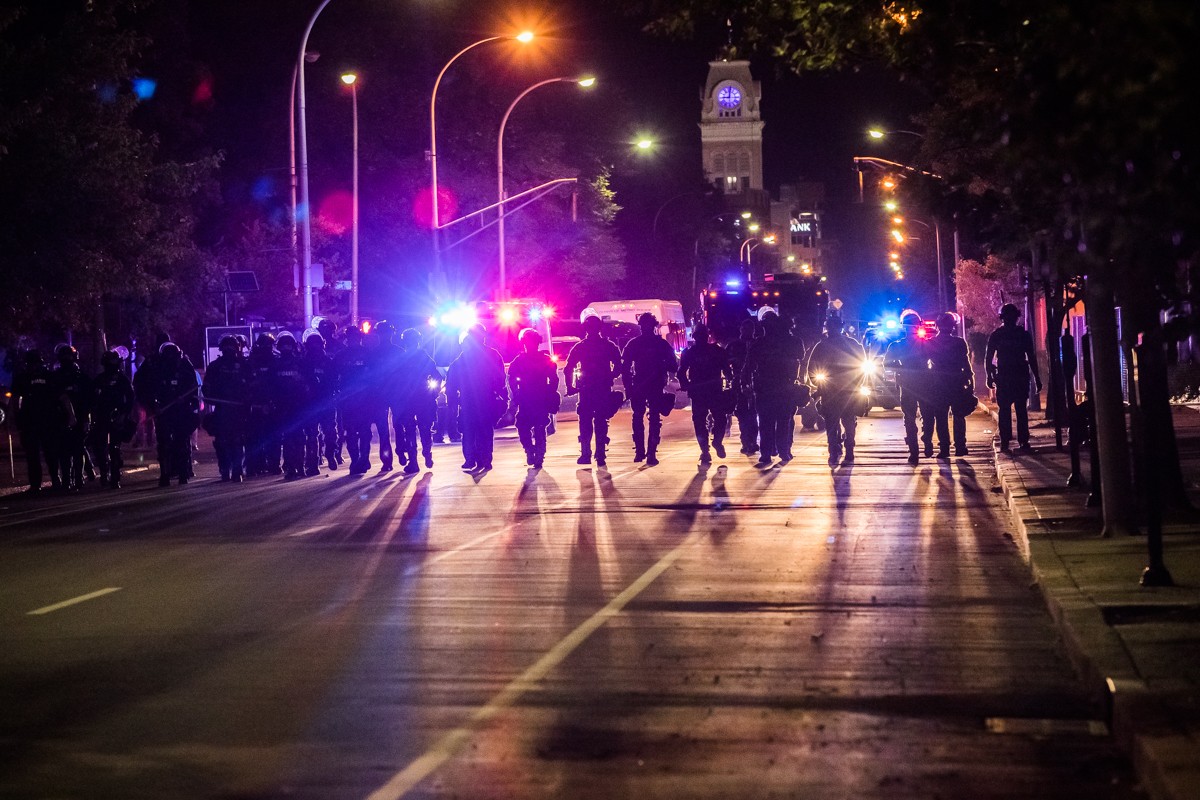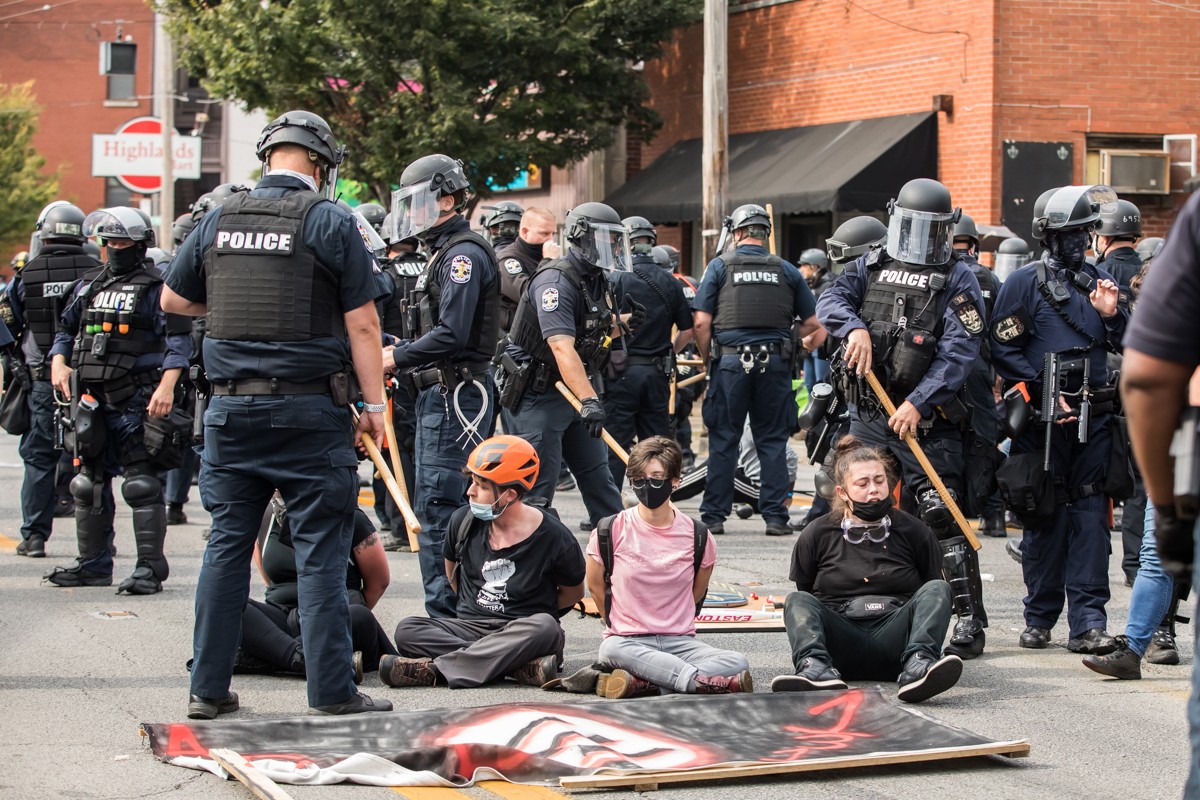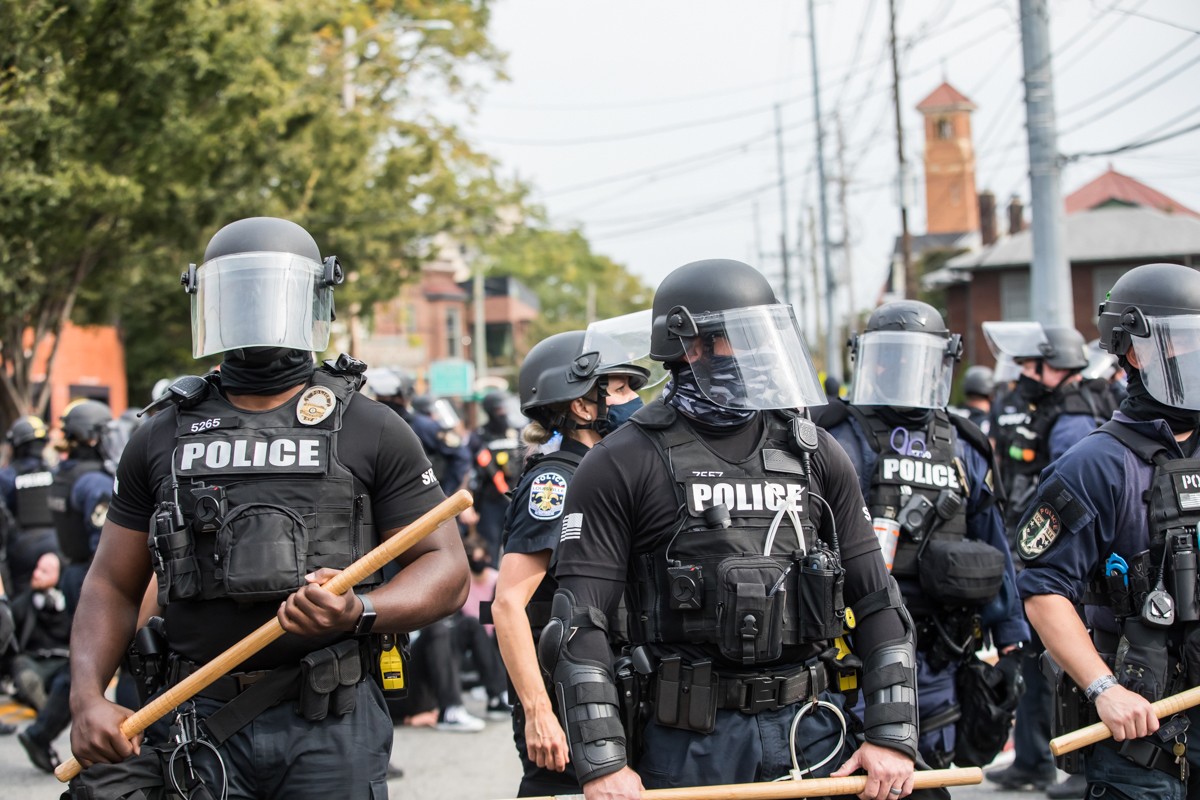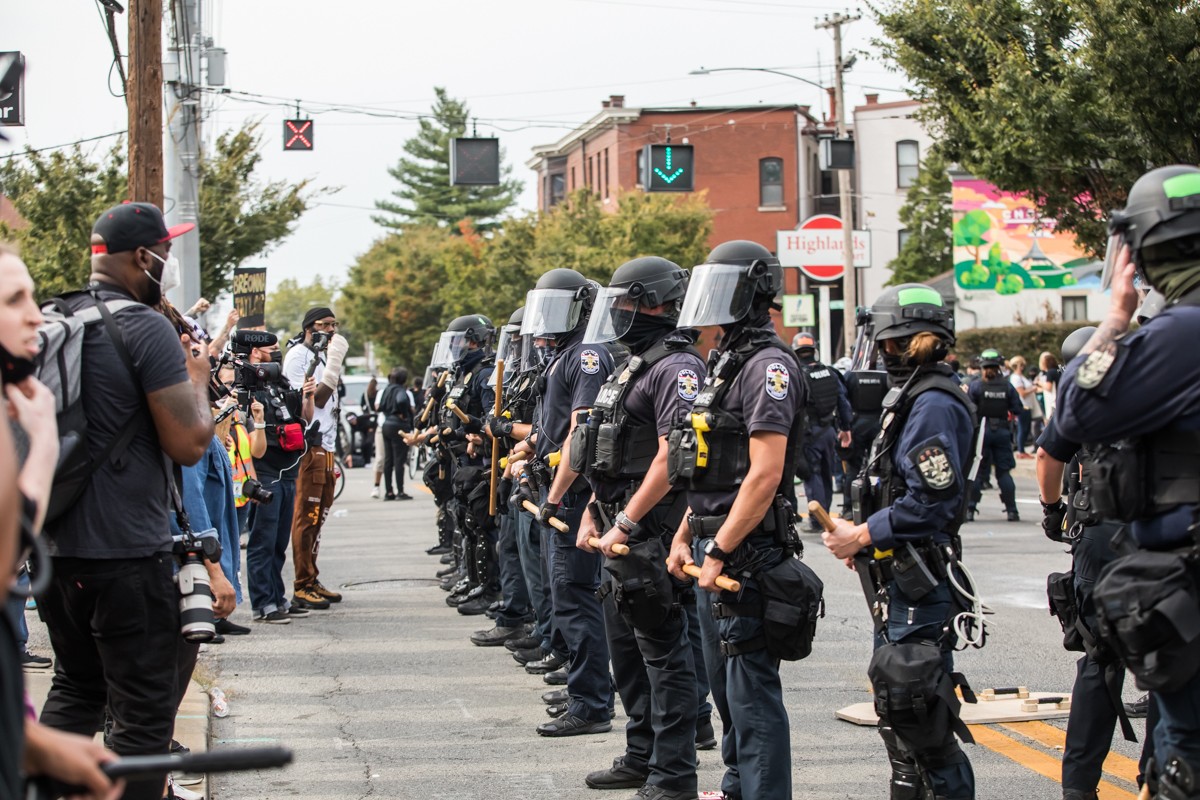State Rep. Attica Scott had a few minutes left before curfew. So, she and other activists were heading for sanctuary at First Unitarian Church on Fourth Street. Suddenly Louisville police surrounded them, some yelling and some, she said, with guns drawn.
Within minutes, Scott, her daughter Ashanti, Louisville activist Shameka Parrish-Wright and a group of others were arrested. Scott was charged with two misdemeanor counts of unlawful assembly and failure to disperse, along with first-degree rioting, a Class D felony. Police allege Scott was part of a group that tried to set fire to the library, even though a video captured by Scott shows she was not involved.
How police treated Kentucky’s only Black woman legislator that evening is but one example of what protesters have called a consistently over-aggressive response to peaceful demonstrations, marred by a few instances of property damage and one person who shot at and injured two officers. While police have reigned in use of tear gas since the earliest days of the protests in late May and early June, they are still using pepper balls, batons, flash bang grenades, blockades and other shows of force in response to protesters. The protests and the use of force escalated again last week when a Grand Jury, under Attorney General Daniel Cameron’s suggestion, did not charge any officers for killing Breonna Taylor.
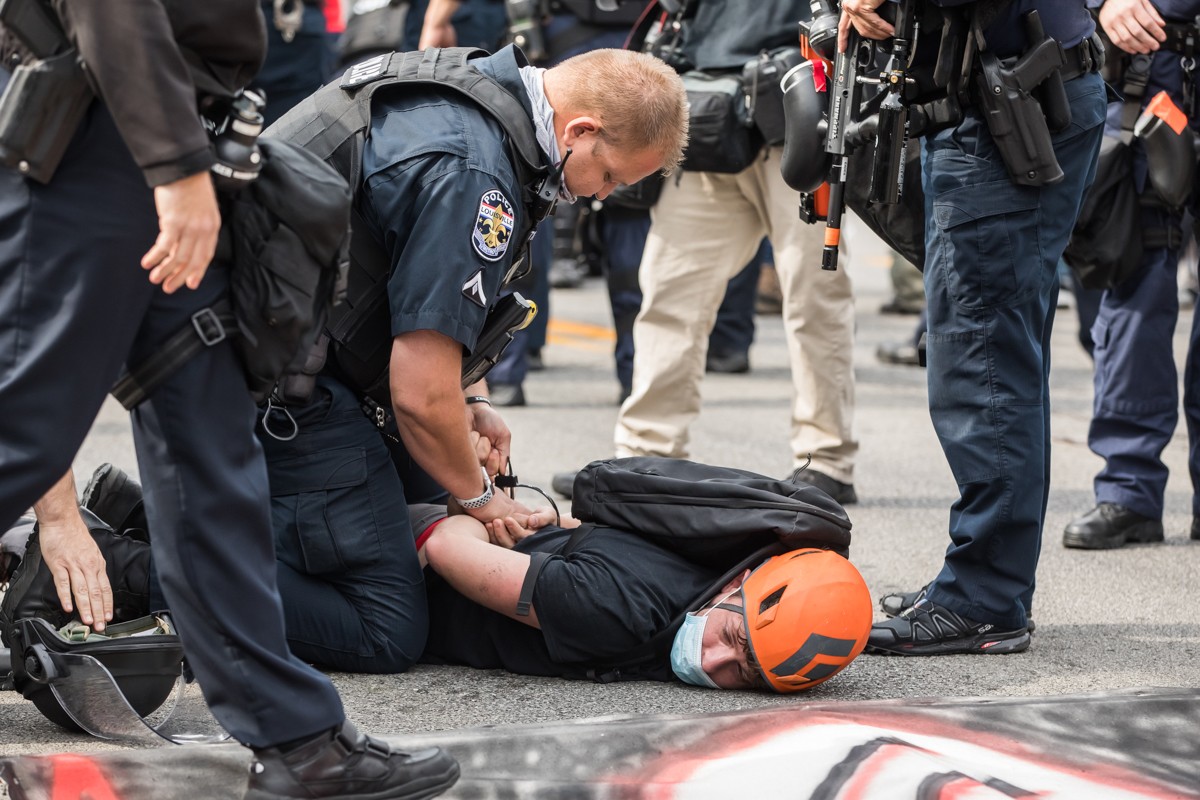
Scott, arrested the day after that decision, said she believes the police are “setting up” protesters for arrest.
“It’s all about exerting power, domination and control over people who dare to speak up and speak out,” Scott told LEO after a press conference Sunday in which she denied the charges and criticized the police tactics that evening. “It’s to send a clear message: ‘We can do whatever we want to, to whoever we want to, at any time.’”
During testimony before the Metro Council, interim Police Chief Robert Schroeder tried to explain when and why police use force on protesters.
“If you look at Jefferson Square Park, we have no visible presence,” he said. “We are allowing people to express themselves, to air their grievances, to do the general First Amendment type activity and as long as they are doing it in a peaceful manner. When you talk about interactions with the public, typically we are only interacting when we see behavior that starts to become alarming, to ask where we think there is a public safety concern.”
Since Wednesday, police have shown up in riot gear to protests near Jefferson Square Park, however.
A Louisville police spokesperson, Jessie Halladay, said some protesters are provoked simply by the police’s presence or their protective gear. “Every day, we are considering what our action, what the consequences of our actions will be.”
Experts and protesters agree that the heavy police presence is provocative, and they also contend officers failed to act proportionately to the protests, serving to worsen confrontations on the streets.
Austin McCoy, an Auburn University assistant professor of history who teaches classes on African American history and who researches social movements and activism, was among the people at Jefferson Square Park on Sunday. He agreed that just having heavily armored officers at protests can cause undue tension.
“A lot of times police presence and police engagement just escalates the protests,” he said. “And a lot of these protests are militant. So if you just add police presence, especially heavy police presence to the environment, then yeah people will respond. And obviously the force is asymmetrical because the police have all the guns. And the law and law enforcement, National Guard, right, they have all the weaponry and all the law behind them and things like that.”
Samuel Walker, a professor emeritus from the University of Nebraska, Omaha, who specializes in civil liberties, policing and criminal justice, said national standards for law enforcement recommend that police make sure they’re not targeting wide swaths of protesters with their tactics.
“You don’t let the actions of a few people out there dictate your response to the entire group,” Walker said. “Let’s say there’s some act of violence, people are throwing something or vandalizing a store of something, [police] then overreact, and their actions are directed against everybody that’s out there. So, that’s where things go wrong.”
But Schroeder has suggested that Louisville police aren’t always following this standard. At a press conference, Schroeder said that any protester can be arrested and charged with rioting if they’re near other people who are destroying property.
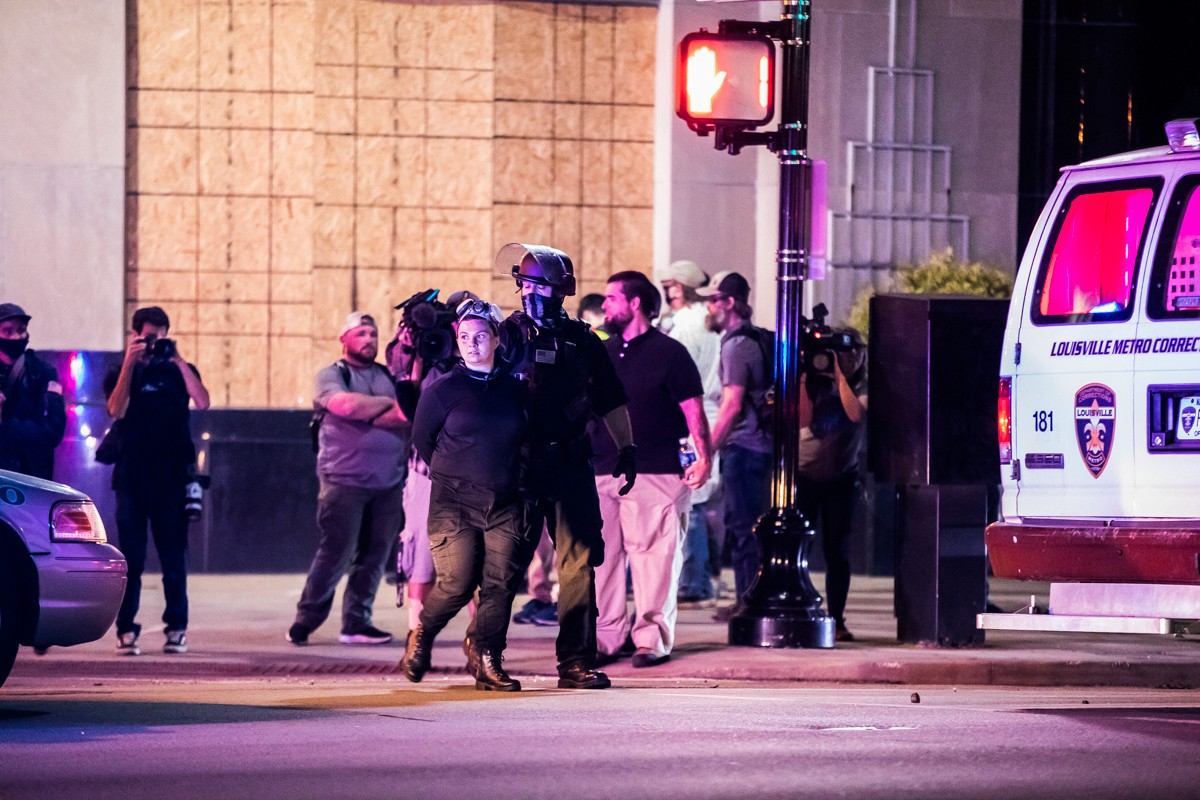
“It does not require an individual to actually have participated in a specific, destructive act,” he said. “As you heard Mayor Fischer say, we encourage people to separate themselves from any damage or any unlawful activities during the protest.”
When asked about this justification, Walker said, “That doesn’t make any sense at all … You can’t arrest and charge somebody who did not, you know, engage in a criminal act.”
At least one protester claims they were beaten and arrested for just being at a protest where property damage occurred.
Artist Aron Conaway told LEO he drove his electric scooter to The Highlands on Bardstown Road on Wednesday to deliver food to protesters. He set up about 15 to 20 feet from the front line, handing out bananas and other snacks when Louisville police blocked the crowd from advancing. A few people in a crowd of hundreds of peaceful protesters had busted out the window of at least one business and flipped chairs at another restaurant. After a standoff, video taken by onlookers captured police surrounding and then charging into the crowd with wooden batons, pushing and aggressively arresting some protesters.
Conaway said he was one of them, although he wasn’t actively protesting. A video from the scene shows one officer bumping another officer who falls backward and runs into a man on a red scooter who is turning around to leave. Conaway says the man is him. The officer who fell into Conaway tackles him, with more police joining in, dragging Conaway around and pinning him. Conaway said that he decided to leave as he heard yelling and saw protesters running toward him. The officers who arrested Conaway hit him and shot pepper spray into his eyes, he said. Conaway suffered a fractured rib and a bump to the head even though he was wearing a helmet.
https://twitter.com/Julio_Rosas11/status/1308861115221381120?s=20An arrest citation that Conaway shared with LEO shows that he was charged with wanton endangerment and three misdemeanors: resisting arrest, failure to disperse and disorderly conduct in the second degree. The arrest report says Conaway attempted to strike the officer with his scooter. Conaway denies this, and he said he told the officer this while being arrested. Conaway’s wanton endangerment charge is listed as first degree, a Class D felony, on his arrest citation, but Conaway said an officer told him it had been dropped to second degree, which is a misdemeanor.
Five days later, Conaway said, he was still struggling to get out of bed due to his injuries. He believes that when police use excessive force on protesters, they’re purposefully agitating the crowd.
“LMPD is just adding insult to injury with this entire situation ... stopping an absolutely peaceful protests in its tracks and inciting violence and then creating this theatrical production that made it to be some type of conflict,” he said.
Aaron Tucek, a legal fellow with the American Civil Liberties Union of Kentucky, said that Louisville police don’t seem to be resorting to tear gas immediately on protesters anymore, but he’s worried that they’re engaging in more shows of force like they did on Bardstown Road.
“I think the level of brute force being applied to you is scary,” he said. The ACLU has been concerned about use of force since the protests began in May.
In July, the ACLU filed a lawsuit against the city for using crowd control weaponry on protesters in the early days of the demonstrations, including tear gas, flash bangs, pepper balls and batons. Scott is a plaintiff in the lawsuit. She said a police officer pushed her and she was tear gassed while peacefully protesting downtown.
Tyra Walker, the co-chair of the Kentucky Alliance Against Racist and Political Repression, is another activist who says she’s a victim of excessive force. On Wednesday, she went to Jefferson Square Park to clean up trash around 8 p.m. When she saw a few people set fires, she decided to leave. But, she paused in the street on her way to film a line of officers who she said had followed her, according to a video she posted to Facebook. One officer told her to get on the sidewalk, so she did. She thought she heard him continuing to yell at her so she responded. But, it was someone else, and the officer shot a pepper ball over her head.
Walker hurried back to her car and turned off her camera but stayed downtown, not willing to leave until she knew the other members of her group were safe. An officer shouted at her to leave and fired another pepper ball at her car, which was a rental, damaging it, she said. Since June, Walker has been talking with Louisville police about not using excessive force on protesters.
“Y’all can’t tell us how to protest, because a protest is a protest. There’s going to be obstruction of justice,” Walker said she told the Louisville police. “And that’s when, you know, one of the majors was like, well, be prepared to be arrested. And I said, as long as I’m not tackled. I’ll be arrested, just don’t tackle me or anybody else.”
Walker said her stepfather is a chaplain for the Jefferson County Sheriff’s Office and her dad used to be a Louisville police officer. “My daddy served this city, and I ended up being traumatized by the city he served,” she said.
Metro Councilman Anthony Piagentini, an outspoken police advocate and Republican, said he believes that police have acted appropriately. He said he watches livestreams filmed by members of the media and LMPD.
“There’s no such thing as an organization as big as LMPD and they do things perfectly 100% of the time, all the time, right?” he said. “In the reports that I’ve seen overall, I think LMPD has done a very professional and very good job in maintaining the peace.”
As proof, Piagentini pointed to the fact that, on Thursday evening, only 24 people were arrested at the protests. And, when two police officers were shot by someone at the protests on Wednesday night, no officers fired their guns back at the crowd. He said he wouldn’t propose any “sweeping” changes to the way LMPD has been handling the protests.
Metro Councilman Brandon Coan, a Democrat whose district includes The Highlands, is working on an ordinance that would restrict use of chemical agents by Louisville police, including tear gas and pepper balls. He’s also worried about other tactics police have been using over the past few days, including blocking protesters from continuing their marches.
“I think that law enforcement response to that has to be more pointed at individuals,” he said. “Because otherwise it creates an atmosphere where people who just come down to peaceably assemble and peaceably express themselves feel like targets and that should never be the case.”

